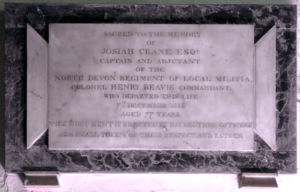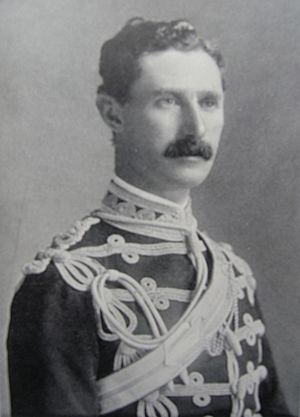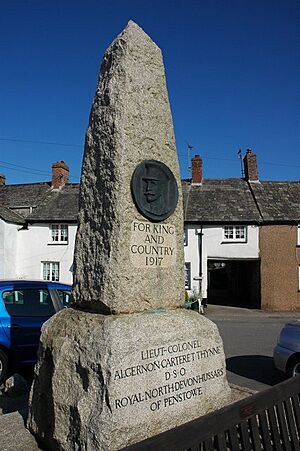Royal North Devon Yeomanry facts for kids
Quick facts for kids Royal North Devon Yeomanry |
|
|---|---|
| Active | 1798 – 7 June 1920 |
| Country | |
| Branch | |
| Type | Yeomanry |
| Size | Regiment |
| Garrison/HQ | Barnstaple |
| Engagements | Second Boer War First World War |
The Royal North Devon Yeomanry was a special kind of British Army regiment. It was made up of volunteers, often horse riders. This group was first started in 1798. They fought in the Second Boer War and the First World War. In 1920, they joined with another group, the Royal 1st Devon Yeomanry. Together, they became the Royal Devon Yeomanry.
Contents
History of the Royal North Devon Yeomanry
How the Regiment Started
Around 1793, Britain worried about being invaded by France. The British government needed more soldiers to protect the country. So, in 1794, they asked for volunteers. These mounted volunteers were called "Gentlemen and Yeomanry Cavalry."
The Royal North Devon Yeomanry began in 1798. It started as separate small groups. A key person in forming these groups was Colonel John Rolle, 1st Baron Rolle. In 1803, these groups officially became the North Devonshire Mounted Rifles.
Keeping Peace at Home
Even after the Napoleonic Wars ended in 1815, the Yeomanry stayed active. They helped the police keep order because there were no organized police forces yet. For example, in 1816, a crowd tried to break into a prison in Bideford. Members of the Regiment quickly arrived and patrolled the town. They arrested several rioters.
The government did not always want to pay for the Yeomanry. Many groups were disbanded between 1827 and 1828. However, the North Devonshire Regiment of Yeomanry Cavalry was never officially disbanded. They even served for free from 1828 to 1831.
The regiment changed its name a few times. In 1856, it became the Royal North Devonshire Regiment of Yeomanry Cavalry. By 1868, it was known as the Royal North Devon Hussars. Their main base was in Barnstaple.
Fighting in the Second Boer War
In December 1899, Britain faced difficulties in the Second Boer War in South Africa. The government needed more soldiers. They created the Imperial Yeomanry to allow volunteers to join the fight. Existing Yeomanry regiments were asked to provide companies of about 115 men.
The Royal North Devon Hussars and the Royal 1st Devon Yeomanry worked together. They formed the 27th (Devonshire) Company. This company arrived in South Africa in March 1900.
In 1901, the regiment changed its name again to the Royal North Devonshire Imperial Yeomanry. It was organized into four squadrons and a machine gun section. On April 1, 1908, it became the Royal North Devon Yeomanry for the last time. It joined the Territorial Force and was trained like hussars, who were light cavalry soldiers. Their base was at Bear Street in Barnstaple.
The regiment had its headquarters in Barnstaple. Its squadrons were spread across Devon:
- A Squadron was in Holsworthy.
- B Squadron was in Barnstaple.
- C Squadron was in South Molton.
- D Squadron was in Torrington.
The First World War (1914-1918)
When the First World War began in 1914, the Royal North Devon Yeomanry was part of the 2nd South Western Mounted Brigade. Many members volunteered to serve overseas. Because of this, the regiment was split into different "Lines":
- 1st Line: For overseas service.
- 2nd Line: For home defense.
- 3rd Line: A reserve to train new soldiers.
1st Line: Fighting Overseas
The 1st Line regiment moved to Colchester in England. In September 1915, they gave up their horses and became infantry (foot soldiers).
Gallipoli Campaign (1915)
In September 1915, the regiment sailed from Liverpool. They arrived in Mudros and then went to Suvla Bay. On October 9, they landed in Gallipoli 1915, a peninsula in Turkey. They helped dig trenches and fought alongside other divisions. In December, they were evacuated to Imbros.
Two officers from the regiment died in Gallipoli:
- Major Morland Greig
- Captain John Oliver Clemson
Defending Egypt (1916–1917)
On December 30, 1915, the regiment landed in Alexandria to help defend Egypt 1916–17. In February 1916, they joined the 2nd Dismounted Brigade. They helped guard the Suez Canal. On January 4, 1917, they combined with the 1/1st Royal 1st Devon Yeomanry. They formed the 16th (Royal 1st Devon and Royal North Devon Yeomanry) Battalion, Devonshire Regiment. This new battalion became part of the 74th (Yeomanry) Division.
Battles in Palestine (1917–1918)
With the 74th Division, the battalion took part in the invasion of Palestine 1917–18. They fought in the Second Battle of Gaza and the Third Battle of Gaza. This included capturing Beersheba and the Sheria Position. Later in 1917, they helped capture and defend Jerusalem. In March 1918, they fought in the Battle of Tell 'Asur. By April 1918, the division was sent to France.
Western Front in France and Flanders (1918)
On May 7, 1918, the 16th Battalion landed in Marseilles, France. They served in France and Flanders 1918 for the rest of the war. From September 1918, they were part of the Hundred Days Offensive. This included battles like the Second Battle of the Somme and battles along the Hindenburg Line. By the end of the war, they were near Tournai, Belgium.
2nd Line: Home Defense
The 2nd Line regiment formed in Barnstaple in September 1914. They moved to Colchester in September 1915. In July 1916, they became a cyclist unit. They were part of the 2nd Cyclist Brigade in Suffolk. In November 1916, they combined with the 2/1st Royal 1st Devon Yeomanry. They formed the 4th (Royal 1st Devon and North Devon) Yeomanry Cyclist Regiment. In March 1917, they went back to being the 2/1st Royal North Devon Yeomanry. In May 1918, they moved to Ireland and stayed there until the war ended.
3rd Line: Training New Soldiers
The 3rd Line regiment formed in Barnstaple in 1915. They trained new recruits. In 1916, they stopped using horses. They were disbanded in early 1917. Their soldiers either joined the 2nd Line regiment or other battalions.
After the First World War
On February 7, 1920, the Regiment was reformed in the Territorial Army. Their headquarters remained in Barnstaple. After the war, it was decided that only a few Yeomanry regiments would remain as cavalry. The others would change roles.
So, on June 7, 1920, the Royal North Devon Yeomanry combined with the Royal 1st Devon Yeomanry. They formed the Royal Devon Yeomanry. At the same time, they became part of the Royal Artillery. They were renamed the 11th (Devon) Army Brigade, RFA.
Regimental Museum
You can learn more about the Royal Devon Yeomanry at the Royal Devon Yeomanry Museum. It is part of the Museum of Barnstaple and North Devon in Barnstaple.
Commanding Officers
Some of the important leaders of the North Devon Hussars included:
- Sir Robert Bourchier Sherard Wrey, 11th Baronet
- Hugh Fortescue, 4th Earl Fortescue (an Honorary Colonel)
- Robert Sanders, 1st Baron Bayford
- Lt-Col. Algernon Carteret Thynne. He was killed in action in Palestine during World War I. There is a monument for him in Kilkhampton, Cornwall.
- Lt Col. Collis George Herbert St. Hill. He was killed in action in France in 1917. There is a monument for him in Bradninch Church, Devon.
Battle Honours
The Royal North Devon Yeomanry earned special "battle honours" for their bravery. These honors are often displayed on their regimental flags.
- Second Boer War: South Africa 1900–01
- First World War: Somme 1918, Bapaume 1918, Hindenburg Line, Épéhy, France and Flanders 1918, Gallipoli 1915, Egypt 1916–17, Gaza, Jerusalem, Tell 'Asur, Palestine 1917–18
Images for kids
See also
- Imperial Yeomanry
- List of Yeomanry Regiments 1908
- Yeomanry
- British yeomanry during the First World War







